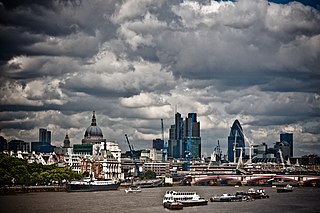
Liquidation is the process in accounting by which a company is brought to an end in Canada, United Kingdom, United States, Ireland, Australia, New Zealand, Italy, and many other countries. The assets and property of the company are redistributed. Liquidation is also sometimes referred to as winding-up or dissolution, although dissolution technically refers to the last stage of liquidation. The process of liquidation also arises when customs, an authority or agency in a country responsible for collecting and safeguarding customs duties, determines the final computation or ascertainment of the duties or drawback accruing on an entry.
In law, receivership is a situation in which an institution or enterprise is held by a receiver—a person "placed in the custodial responsibility for the property of others, including tangible and intangible assets and rights"—especially in cases where a company cannot meet its financial obligations and is said to be insolvent. The receivership remedy is an equitable remedy that emerged in the English chancery courts, where receivers were appointed to protect real property. Receiverships are also a remedy of last resort in litigation involving the conduct of executive agencies that fail to comply with constitutional or statutory obligations to populations that rely on those agencies for their basic human rights.
A floating charge is a security interest over a fund of changing assets of a company or other legal person. Unlike a fixed charge, which is created over ascertained and definite property, a floating charge is created over property of an ambulatory and shifting nature, such as receivables and stock.

Salomon v A Salomon & Co Ltd[1896] UKHL 1, [1897] AC 22 is a landmark UK company law case. The effect of the House of Lords' unanimous ruling was to uphold firmly the doctrine of corporate personality, as set out in the Companies Act 1862, so that creditors of an insolvent company could not sue the company's shareholders for payment of outstanding debts.

In finance, a security interest is a legal right granted by a debtor to a creditor over the debtor's property which enables the creditor to have recourse to the property if the debtor defaults in making payment or otherwise performing the secured obligations. One of the most common examples of a security interest is a mortgage: a person borrows money from the bank to buy a house, and they grant a mortgage over the house so that if they default in repaying the loan, the bank can sell the house and apply the proceeds to the outstanding loan.
An unfair preference is a legal term arising in bankruptcy law where a person or company transfers assets or pays a debt to a creditor shortly before going into bankruptcy, that payment or transfer can be set aside on the application of the liquidator or trustee in bankruptcy as an unfair preference or simply a preference.
As a legal concept, administration is a procedure under the insolvency laws of a number of common law jurisdictions, similar to bankruptcy in the United States. It functions as a rescue mechanism for insolvent entities and allows them to carry on running their business. The process – in the United Kingdom colloquially called being "under administration" – is an alternative to liquidation or may be a precursor to it. Administration is commenced by an administration order.

Re Spectrum Plus Ltd[2005] UKHL 41 was a UK company law decision of House of Lords that settled a number of outstanding legal issues relating to floating charges and recharacterisation risk under the English common law. However, the House of Lords also discussed the power of the court to make rulings as to the law that were "prospective only" to mitigate potential harshness when issuing a ruling that was different from what the law had previously been understood to be.

United Kingdom insolvency law regulates companies in the United Kingdom which are unable to repay their debts. While UK bankruptcy law concerns the rules for natural persons, the term insolvency is generally used for companies formed under the Companies Act 2006. Insolvency means being unable to pay debts. Since the Cork Report of 1982, the modern policy of UK insolvency law has been to attempt to rescue a company that is in difficulty, to minimise losses and fairly distribute the burdens between the community, employees, creditors and other stakeholders that result from enterprise failure. If a company cannot be saved it is liquidated, meaning that the assets are sold off to repay creditors according to their priority. The main sources of law include the Insolvency Act 1986, the Insolvency Rules 1986, the Company Directors Disqualification Act 1986, the Employment Rights Act 1996 Part XII, the EU Insolvency Regulation, and case law. Numerous other Acts, statutory instruments and cases relating to labour, banking, property and conflicts of laws also shape the subject.
Report of the Review Committee on Insolvency Law and Practice (1982) Cmnd 8558, also known as the "Cork Report" was an investigation and set of recommendations on modernisation and reform of UK insolvency law. It was chaired by Kenneth Cork and was commissioned by the Labour government in 1977. The Cork Report was followed by a White Paper in 1984, A Revised Framework for Insolvency Law (1984) Cmnd 9175, and these led to the Insolvency Act 1986.

Illingworth v Houldsworth [1904] AC 355 is a UK insolvency law case, concerning the taking of a security interest over a company's assets with a floating charge. In the Court of Appeal Romer LJ held that a key to a floating charge, as opposed to a fixed charge was that the company can carry on its business with assets subject to the charge.

Re Parkes Garage (Swadlincote) Ltd [1929] 1 Ch 139 is a leading UK insolvency law case, concerning a voidable floating charge for past value.
Administration in United Kingdom law is the main kind of procedure in UK insolvency law when a company is unable to pay its debts. The management of the company is usually replaced by an insolvency practitioner whose statutory duty is to rescue the company, save the business, or get the best result possible. It is the equivalent of Chapter 11, Title 11, United States Code, although with significant differences. While creditors with a security interest over all a company's assets could control the procedure previously through receivership, the Enterprise Act 2002 made administration the main procedure.

Buchler v Talbot[2004] UKHL 9 is a UK insolvency law case, concerning the priority of claims in a liquidation. Under English law at the time the expenses of liquidation took priority over the preferred creditors, and the preferred creditors took priority over the claims of the holder of a floating charge. However, a crystallised floating charge theoretically took priority over the liquidation expenses. Accordingly the courts had to try and reconcile the apparent triangular conflict between priorities.

The British Virgin Islands company law is the law that governs businesses registered in the British Virgin Islands. It is primarily codified through the BVI Business Companies Act, 2004, and to a lesser extent by the Insolvency Act, 2003 and by the Securities and Investment Business Act, 2010. The British Virgin Islands has approximately 30 registered companies per head of population, which is likely the highest ratio of any country in the world. Annual company registration fees provide a significant part of Government revenue in the British Virgin Islands, which accounts for the comparative lack of other taxation. This might explain why company law forms a much more prominent part of the law of the British Virgin Islands when compared to countries of similar size.

British Virgin Islands bankruptcy law is principally codified in the Insolvency Act, 2003, and to a lesser degree in the Insolvency Rules, 2005. Most of the emphasis of bankruptcy law in the British Virgin Islands relates to corporate insolvency rather than personal bankruptcy. As an offshore financial centre, the British Virgin Islands has many times more resident companies than citizens, and accordingly the courts spend more time dealing with corporate insolvency and reorganisation.

Cayman Islands company law is primarily codified in the Companies Law and the Limited Liability Companies Law, 2016, and to a lesser extent in the Securities and Investment Business Law. The Cayman Islands is a leading offshore financial centre, and financial services form a significant part of the economy of the Cayman Islands. Accordingly company law forms a much more prominent part of the law of the Cayman Islands than might otherwise be expected.

Cayman Islands bankruptcy law is principally codified in five statutes and statutory instruments:

Re Brightlife Ltd [1987] 1 Ch 200 is a UK insolvency law case, concerning the conversion of a floating charge into a fixed charge ("crystallisation"). It held that an automatic crystallisation clause was part of the parties’ freedom of contract. It could not be limited by court created public policy exceptions. The significance of the case was largely outpaced by the Insolvency Act 1986 section 251, which said a floating charge was one that was created as a floating charge.

Hong Kong insolvency law regulates the position of companies which are in financial distress and are unable to pay or provide for all of their debts or other obligations, and matters ancillary to and arising from financial distress. The law in this area is now primarily governed by the Companies Ordinance and the Companies Rules. Prior to 2012 Cap 32 was called the Companies Ordinance, but when the Companies Ordinance came into force in 2014, most of the provisions of Cap 32 were repealed except for the provisions relating to insolvency, which were retained and the statute was renamed to reflect its new principal focus.